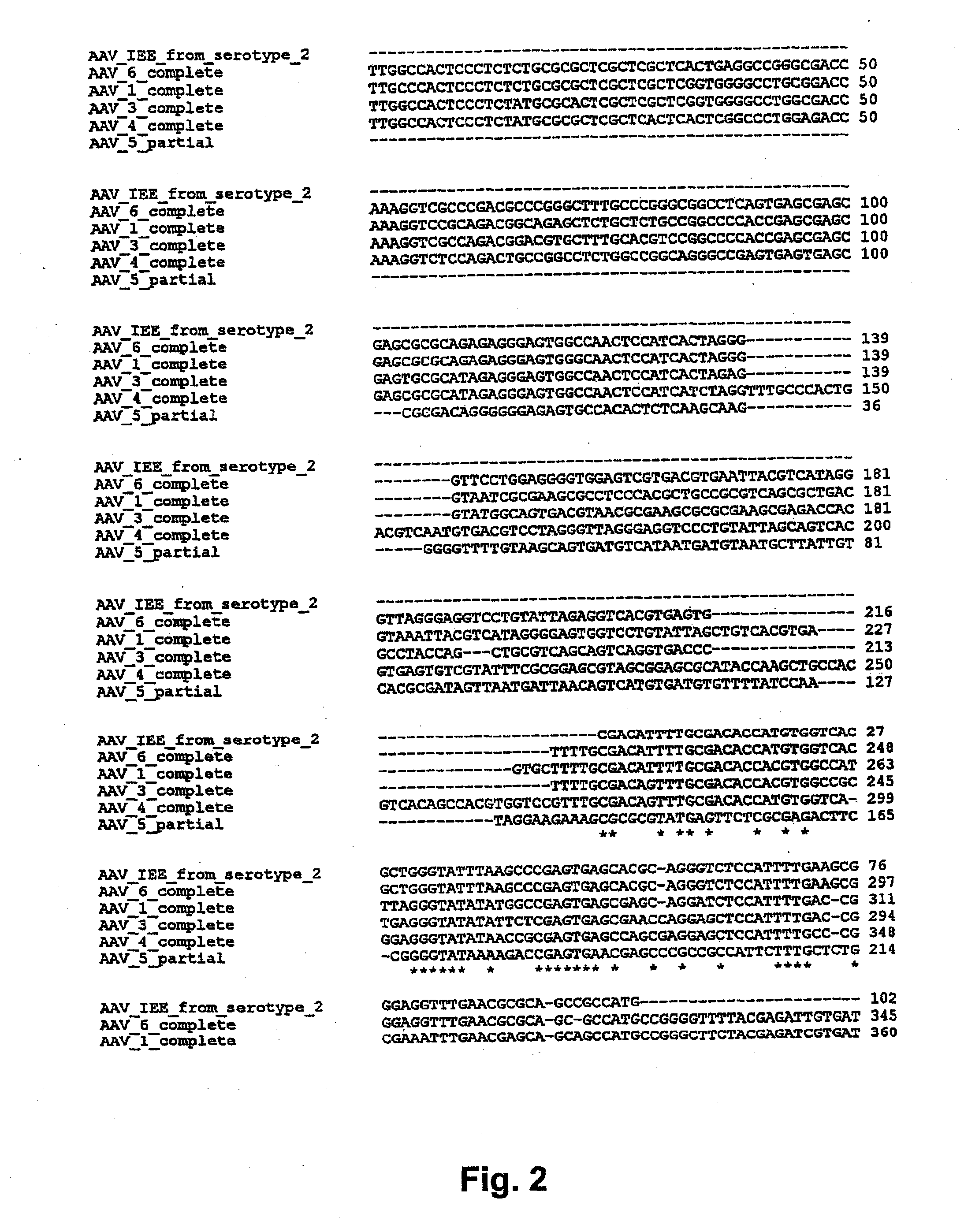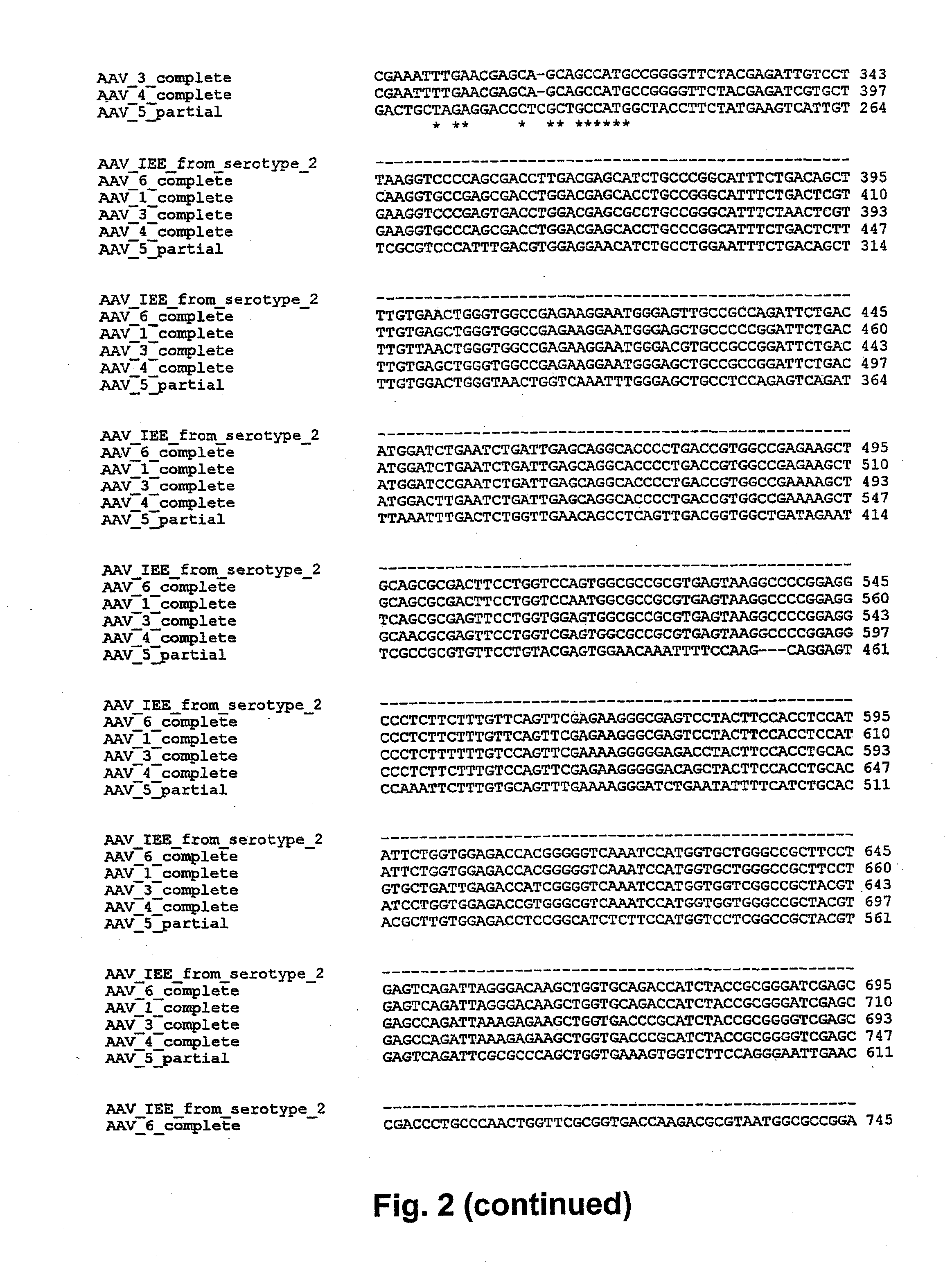Use of aav integration efficiency element for mediating site-specific integration of a transcription unit
a transcription unit and efficiency element technology, applied in the field of expression constructs, can solve the problems of adverse reactions, limited applicability and efficacy of all these gene delivery systems, and limited host range of retroviruses
- Summary
- Abstract
- Description
- Claims
- Application Information
AI Technical Summary
Benefits of technology
Problems solved by technology
Method used
Image
Examples
example 1
[0073]This example illustrates that a cis-acting element, other than AAV ITRs, functions as an integration efficiency element.
[0074]Two recombinant AAV (rAAV) plasmids were constructed from adeno-associated virus 2 (pRepGFP and pGFPCap). pRepGFP was constructed to contain, from 5′ to 3′, an AAV ITR, the Rep ORF operably linked to a nucleic acid sequence encoding an AAV IEE, a GFP transgene operably linked to a CMV promoter, and a second AAV ITR. pGFPCap was constructed to contain, from 5′ to 3′, an AAV ITR, a nucleic acid sequence encoding an AAV EE, a GFP transgene operably linked to a CMV promoter, the second half of the wt AAV genome including the AAV Cap ORF, and a second AAV ITR. In addition, pTRUF2, which is a well-known rAAV plasmid, was utilized to analyze the integration efficiency of an expression construct which lacks a nucleic acid sequence encoding an AAV IEE. In that respect, pTRUF2 contains, from 5′ to 3′, an AAV ITR, a GFP transgene and a neomycin resistance gene ope...
example 2
[0077]This example demonstrates that the deletion of AAV ITRs in a recombinant AAV plasmid does not influence the efficiency of Rep mediated site-specific integration.
[0078]Plasmids were constructed as described in Example 1 but with complete deletions of AAV ITRs. HeLa cells were co-transfected with pSub201 and either of pRepGFP(ITR−), pGFPCap(ITR−), or pTRUF2(ITR−). Transfected cells were sorted, plated, and grown as described in Example 1. Whole cell DNA was isolated from HeLa cells as described in Example 1. PCR and Southern Blots were performed to screen for GFP expression to determine if site-specific integration had occurred. The results are summarized in Table 2.
TABLE 2PlasmidIntegration Efficiency RatepRepGFP(ITR−)27%pGFPCap(ITR−) 5%pSub201(ITR−)12%pTRUF2(ITR−)
[0079]As indicated by the results set forth in Table 2, expression constructs lacking AAV ITRs integrated into the host cell genome by Rep-mediated site-specific integration at a similar efficiency to their ITR-contai...
example 3
[0080]This example further demonstrates that AAV-ITR elements are not required for AAV site-specific integration.
[0081]HeLa cells were transfected with a pAAV / Ad plasmid (pRepCap(itr−)) (Samulski et al., J. Virol., 63, 3822-3828 (1989)) and a pCMV-GFB plasmid (Philpott et al., Proc. Natl. Acad. Sci., 99(19), 12381-12385 (2002)). pRepCap(itr−) contains wild-type AAV sequences with both flanking ITR elements deleted. pCMV-GFB expresses GFP and does not contain an AAV sequence. As a control, HeLa cells were transfected with a pSub201 plasmid (pRepCap(itr+)) (containing wild-type AAV sequences including both flanking ITR elements) and a pCMV-GFB plasmid.
[0082]Transfected cells were sorted by fluorescence-activated cell sorting (FACS) after 48 hours (Beckman-Coulter Altra cell sorter). The sorted cells were plated on a 96 well plate with 1 cell / well, and the cells were allowed to grow for approximately 6 weeks. After this time, genomic DNA was isolated from HeLa cells using a standard pr...
PUM
| Property | Measurement | Unit |
|---|---|---|
| nucleic acid sequence | aaaaa | aaaaa |
| stability | aaaaa | aaaaa |
| length | aaaaa | aaaaa |
Abstract
Description
Claims
Application Information
 Login to View More
Login to View More - R&D
- Intellectual Property
- Life Sciences
- Materials
- Tech Scout
- Unparalleled Data Quality
- Higher Quality Content
- 60% Fewer Hallucinations
Browse by: Latest US Patents, China's latest patents, Technical Efficacy Thesaurus, Application Domain, Technology Topic, Popular Technical Reports.
© 2025 PatSnap. All rights reserved.Legal|Privacy policy|Modern Slavery Act Transparency Statement|Sitemap|About US| Contact US: help@patsnap.com



